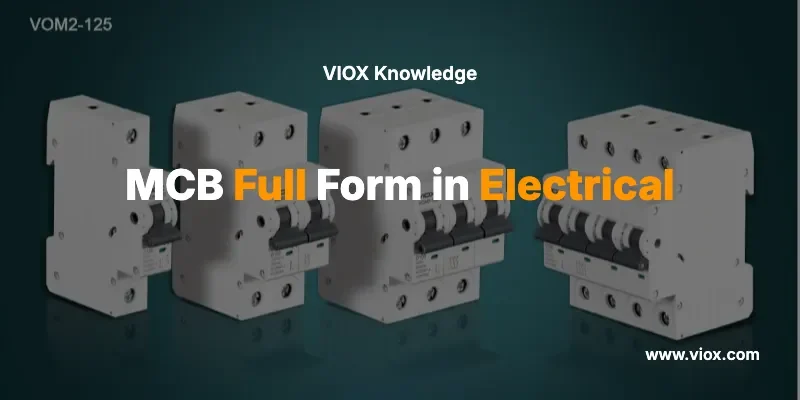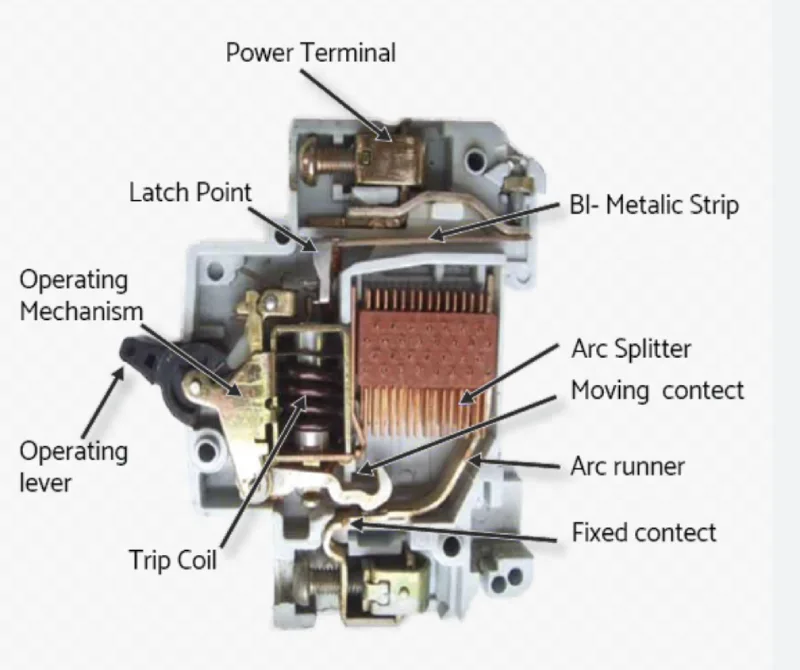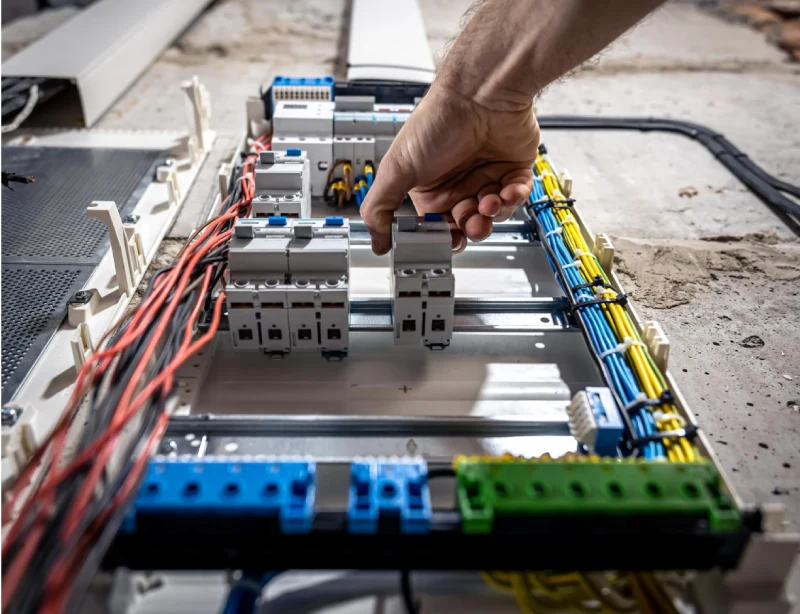MCB Full Form in Electrical
MCB full form is “Miniatuurne kaitselüliti“ – a critical electrical safety device that automatically disconnects electrical circuits when overcurrent, short circuits, or fault conditions are detected. The MCB full form represents one of the most important protective devices in modern electrical installations.
Kiire vastus: MCB stands for Miniature Circuit Breaker, which protects electrical circuits from damage by automatically cutting power during dangerous electrical conditions.
Understanding the MCB full form and its applications is crucial for electrical safety, code compliance, and proper circuit protection in residential, commercial, and industrial applications.
MCB Full Form Explained: What Does MCB Stand For?
The MCB full form – Miniature Circuit Breaker – tells you exactly what this device does:
- Miniature: Compact size compared to larger circuit breakers
- Circuit: Protects electrical circuits and pathways
- Breaker: Breaks or interrupts electrical flow during faults
Other Common MCB Full Form Variations
| Abbreviation | Täielik vorm | Context |
|---|---|---|
| MCB | Miniatuurne kaitselüliti | Standard electrical term |
| MCB | Motor Circuit Breaker | Motor protection applications |
| MCB | Magnetic Circuit Breaker | Emphasizing magnetic trip mechanism |
What is MCB in Electrical Systems?
A Miniature Circuit Breaker (MCB) is an automatically operated electrical switching device designed to protect electrical circuits from damage caused by overcurrent conditions, including short circuits and overload situations. Unlike traditional fuses that require replacement after operation, MCBs can be reset and reused multiple times.
Key Function: MCBs detect abnormal electrical conditions and immediately disconnect the circuit to prevent equipment damage, electrical fires, and potential electrocution hazards.
MCB vs Other Circuit Protection Devices: Complete Comparison
| Funktsioon | MCB (minikaitselüliti) | MCCB (Molded Case Circuit Breaker) | Kaitsmed | RCD/GFCI |
|---|---|---|---|---|
| Praegune hinnang | 0,5A kuni 125A | 100A to 2500A | 1A to 800A | 25A to 100A |
| Tööpinge | Up to 400V AC | Kuni 1000 V vahelduvvool | Erinevad | Up to 500V AC |
| Mahutavuse purustamine | 6kA to 25kA | 25kA to 200kA | 10 kA kuni 200 kA | 6kA to 25kA |
| Reageerimisaeg | 0.02 to 0.05 seconds | 0.02 to 0.1 seconds | 0.001 to 1 second | 0.025 to 0.04 seconds |
| Taaskasutatavus | Yes (reset after trip) | Yes (reset after trip) | No (replace after blow) | Yes (reset after trip) |
| Kaitse tüüp | Overcurrent & Short Circuit | Overcurrent & Short Circuit | Overcurrent & Short Circuit | Earth Fault & Residual Current |
| Kulud | Madal kuni keskmine | Keskmine kuni kõrge | Väga madal | Keskmine |
| Hooldus | Minimaalne | Regular inspection required | Replacement only | Regular testing required |
| Taotlus | Residential & Light Commercial | Industrial & Heavy Commercial | All applications | Safety protection only |
MCB-de tüübid ja nende rakendused
Classification by Current Characteristics
Type B MCBs (3-5 times rated current)
- Taotlus: Residential lighting and general power circuits
- Trip Range: 3In to 5In (where In = rated current)
- Use Cases: LED lighting, ceiling fans, general outlets
- Kaitse: Moderate inrush current applications
Type C MCBs (5-10 times rated current)
- Taotlus: Commercial and light industrial applications
- Trip Range: 5In to 10In
- Use Cases: Motors, transformers, fluorescent lighting
- Kaitse: Higher inrush current tolerance
Type D MCBs (10-20 times rated current)
- Taotlus: Industrial motors and high inrush equipment
- Trip Range: 10In to 20In
- Use Cases: Large motors, welding equipment, X-ray machines
- Kaitse: Very high inrush current applications
Classification by Number of Poles
| Kaitselüliti tüüp | Kirjeldus | Taotlus | Tööpinge |
|---|---|---|---|
| Single Pole (1P) | Breaks one live conductor | Single-phase AC circuits | 240 V vahelduvvool |
| Double Pole (2P) | Breaks live and neutral | Single-phase with neutral protection | 240 V vahelduvvool |
| Three Pole (3P) | Breaks three live conductors | Three-phase AC circuits | 415V AC |
| Neli Masti (4P) | Breaks three live + neutral | Kolmefaasiline neutraaljuhtmega | 415V AC |
How MCBs Work: Technical Operation
Töömehhanism
1. Termiline kaitse (ülekoormus)
- Bimetallic strip heats up during sustained overcurrent
- Strip bends and triggers trip mechanism
- Response time: 1 second to several minutes depending on overload level
2. Magnetkaitse (lühis)
- Electromagnetic coil generates magnetic field during high current
- Magnetic force pulls trip mechanism instantly
- Response time: 0.02 to 0.05 seconds
3. Arc Extinction
- Arc forms when contacts separate under load
- Arc chute system extinguishes arc safely
- SF6 gas or vacuum chambers in advanced models
⚠️ Ohutus Hoiatus
Always ensure power is completely disconnected before working on MCB installations. Only qualified electricians should install or replace MCBs to ensure compliance with electrical codes and safety standards.
MCB Selection Criteria: Expert Guide
Praegune reitingu valik
Step 1: Calculate Load Current
Load Current = Total Power (W) ÷ Voltage (V) For 3-phase: Load Current = Total Power (W) ÷ (√3 × Line Voltage × Power Factor)
Step 2: Apply Derating Factors
- Ambient temperature derating: 0.8-1.0
- Grouping factor: 0.8-0.95
- Cable derating: As per cable manufacturer
Step 3: Select MCB Rating
- MCB rating should be ≥ 125% of calculated load current
- Must not exceed cable current carrying capacity
- Consider future load expansion (typically 20-30%)
Murdumisvõimsuse valik
| Paigaldamise tüüp | Minimum Breaking Capacity |
|---|---|
| Elamu | 6kA |
| Commercial | 10kA |
| Tööstuslik | 25kA |
| Raske tööstus | 50kA+ |
💡 Eksperdi Nõuanne
Always verify the prospective short circuit current at the point of installation using fault level calculations or measurements. The MCB breaking capacity must exceed the maximum fault current by at least 25% safety margin.
Paigaldus- ja juhtmestikujuhised
Standard Wiring Practices
Single Pole MCB Connection:
- Connect incoming live wire to MCB input terminal
- Connect outgoing live wire to MCB output terminal
- Neutral wire bypasses MCB (connects directly in distribution board)
- Earth wire connects directly to earth bar
Three Pole MCB Connection:
- Connect all three phase wires to respective MCB input terminals
- Connect load phase wires to MCB output terminals
- Maintain proper phase sequence (R-Y-B)
- Use appropriate cable size for each phase
⚠️ Code Compliance Requirements
IEC 60898 Standards:
- MCBs must comply with IEC 60898-1 for AC applications
- Mandatory short circuit and overload testing
- Temperature rise limits and insulation requirements
Riigi Elektri-Kood (NEC) Nõuded:
- Article 240: Overcurrent Protection requirements
- Section 240.4: Protection of conductors
- Section 240.6: Standard ampere ratings
Installation Standards:
- Minimum clearances: 50mm on all sides
- Ambient temperature rating: -25°C to +70°C
- IP20 minimum protection rating for indoor use
Üldised probleemid ja tõrkeotsing
Frequent MCB Tripping Issues
Probleem:
MCB trips immediately after reset
Põhjus:
Short circuit in downstream wiring
Lahendus:
- Disconnect all loads from the circuit
- Test insulation resistance using megger
- Identify and repair short circuit location
- Replace damaged cables if necessary
Probleem:
MCB trips after some time under load
Põhjus:
Overload condition or loose connections
Lahendus:
- Calculate actual load vs MCB rating
- Check all terminal connections for tightness
- Verify cable size adequacy for the load
- Redistribute loads or upgrade MCB rating if needed
Probleem:
MCB doesn’t trip during fault conditions
Põhjus:
MCB failure or incorrect rating
Lahendus:
- Test MCB using appropriate test equipment
- Replace MCB if faulty
- Verify breaking capacity is adequate for installation
🔧 Professional Recommendation
MCB testing should be performed annually in commercial installations and every 3 years in residential applications using calibrated test equipment. Any MCB that fails to trip within specified time-current characteristics should be replaced immediately.
MCB Specifications and Standards
Technical Specifications Table
| Parameeter | Value Range | Standardviide |
|---|---|---|
| Nimivool | 0,5A kuni 125A | IEC 60898-1 |
| Nimipinge | 230V to 400V AC | IEC 60898-1 |
| Sagedus | 50Hz to 60Hz | IEC 60898-1 |
| Mahutavuse purustamine | 6kA to 25kA | IEC 60898-1 |
| Elektriline elu | 10,000 operations | IEC 60898-1 |
| Mehhaaniline elu | 20,000 operations | IEC 60898-1 |
| Temperatuurivahemik | -25°C kuni +70°C | IEC 60898-1 |
| Insulation Voltage | 500V AC for 1 minute | IEC 60898-1 |
Marking and Identification
Mandatory Markings:
- Manufacturer name or trademark
- Type designation and model number
- Rated current and voltage
- Purunemisvõime
- Trip characteristic (B, C, or D)
- Standards compliance (IEC 60898)
Ohutuskaalutlused ja parimad tavad
Installation Safety
Enne paigaldamist:
- Verify power isolation using approved voltage tester
- Check MCB compatibility with existing equipment
- Ensure adequate breaking capacity for installation
- Verify ambient temperature rating
Paigaldamise ajal:
- Use appropriate personal protective equipment (PPE)
- Järgige lukustuse/märgistuse protseduure
- Maintain proper torque on terminal connections
- Verify correct cable sizing and routing
Pärast paigaldamist:
- Test MCB operation using appropriate test equipment
- Verify correct labeling and circuit identification
- Document installation details and test results
- Provide operation instructions to end users
⚠️ Kriitiline Ohutus Märkus
MCBs provide protection against overcurrent conditions but do not protect against electric shock or earth faults. Install RCDs (Residual Current Devices) for comprehensive electrical safety protection.
Cost Analysis and Selection Factors
Initial Cost Comparison
| Kaitselüliti tüüp | Price Range (USD) | Rakenduse sobivus | Elutsükli kulud |
|---|---|---|---|
| Standard MCB | $5 – $25 | Basic residential/commercial | Madal |
| Kõrge purunemisvõime | $15 – $50 | Industrial applications | Keskmine |
| Electronic MCB | $50 – $200 | Precision applications | High initial, low maintenance |
| Smart MCB | $100 – $500 | IoT and monitoring systems | High initial, reduced downtime |
💰 Cost Optimization Tips
- Select appropriate breaking capacity (don’t over-specify)
- Consider bulk purchasing for multiple installations
- Factor in long-term reliability and maintenance costs
- Evaluate smart MCB benefits for critical applications
Tulevased trendid ja tehnoloogia
Smart MCB Technology
- IoT connectivity for remote monitoring
- Ennustavad hooldusvõimalused
- Energy measurement and reporting
- Mobile app integration for real-time status
Täiustatud kaitsefunktsioonid
- Kaarrike tuvastamine ja katkestamine
- Ground fault protection integration
- Communication protocols (Modbus, BACnet)
- Data logging and analysis capabilities
Kiirjuhend
MCB Rating Selection Checklist
- [ ] Calculate maximum load current
- [ ] Apply appropriate derating factors
- [ ] Select MCB rating ≥ 125% of load current
- [ ] Verify cable capacity exceeds MCB rating
- [ ] Confirm breaking capacity for installation
- [ ] Check type characteristic (B, C, or D)
- [ ] Verify voltage and frequency ratings
- [ ] Consider future load expansion
Hädaolukorra protseduurid
- MCB Won’t Reset: Check for short circuit, remove all loads, inspect wiring
- Sage trippimine: Verify load calculations, check connections, test insulation
- No Power After Reset: Check downstream connections, verify MCB operation
- Burning Smell: Immediately disconnect power, inspect for damage, replace if needed
Frequently Asked Questions About MCB Full Form
What is the MCB full form in electrical?
MCB full form is Miniature Circuit Breaker. It’s an automatic electrical switch designed to protect electrical circuits from damage caused by overcurrent conditions including short circuits and overloads.
What does MCB stand for in electrical engineering?
In electrical engineering, MCB stands for Miniature Circuit Breaker – a protective device that combines overcurrent protection with the ability to be reset and reused after operation, unlike traditional fuses.
What is the difference between MCB full form and other circuit breakers?
While MCB stands for Miniature Circuit Breaker (for smaller applications), MCCB stands for Molded Case Circuit Breaker (for larger industrial applications), and ACB stands for Air Circuit Breaker (for very high current applications).
Why is it called a Miniature Circuit Breaker?
The “miniature” in MCB full form refers to its compact size compared to larger industrial circuit breakers, making it ideal for residential and light commercial applications where space is limited.
What is the difference between MCB and MCCB?
MCBs are designed for lower current ratings (up to 125A) and residential/light commercial use, while MCCBs handle higher currents (100A to 2500A) for industrial applications. MCCBs also offer adjustable trip settings and higher breaking capacities.
How do I know if my MCB is faulty?
Signs of MCB failure include: failure to trip during overload, inability to reset after tripping, physical damage or burning marks, loose or corroded terminals, and inconsistent operation. Professional testing is recommended for verification.
Can I replace an MCB with a higher rating?
Only if the downstream wiring and components can safely handle the increased current. The cable current carrying capacity must exceed the new MCB rating, and proper load calculations must be performed.
How often should MCBs be tested?
Residential installations: Every 3 years. Commercial installations: Annually. Industrial installations: Every 6 months or as per maintenance schedule. Critical applications may require more frequent testing.
What causes MCBs to trip frequently?
Common causes include: actual overload conditions, loose terminal connections, damaged cables, moisture ingress, ambient temperature issues, and MCB wear or failure.
Do MCBs protect against electric shock?
No, standard MCBs only protect against overcurrent and short circuits. For electric shock protection, install RCDs (Residual Current Devices) or combination RCBO units.
Conclusion: Understanding MCB Full Form and Applications
The MCB full form – Miniature Circuit Breaker – represents one of the most critical electrical safety devices in modern installations. Understanding what MCB stands for and how these devices function ensures electrical safety, code compliance, and reliable circuit protection.
Key Takeaways About MCB Full Form:
- MCB stands for Miniature Circuit Breaker – essential for electrical protection
- The “miniature” designation refers to compact size for residential/commercial use
- MCB full form encompasses automatic overcurrent and short circuit protection
- Professional installation and regular testing ensure optimal MCB performance
- Combining MCBs with RCDs provides comprehensive electrical protection
For complex electrical installations or questions about MCB full form applications, always consult qualified electrical engineers or certified electricians to ensure safety and code compliance.
Eksperdi soovitus: Understanding the MCB full form is just the beginning – proper selection, installation, and maintenance of Miniature Circuit Breakers requires detailed knowledge of electrical codes, load calculations, and safety standards for optimal electrical system protection.
Seotud
Mis on miniatuurne kaitselüliti (MCB): täielik ohutus- ja valikujuhend





